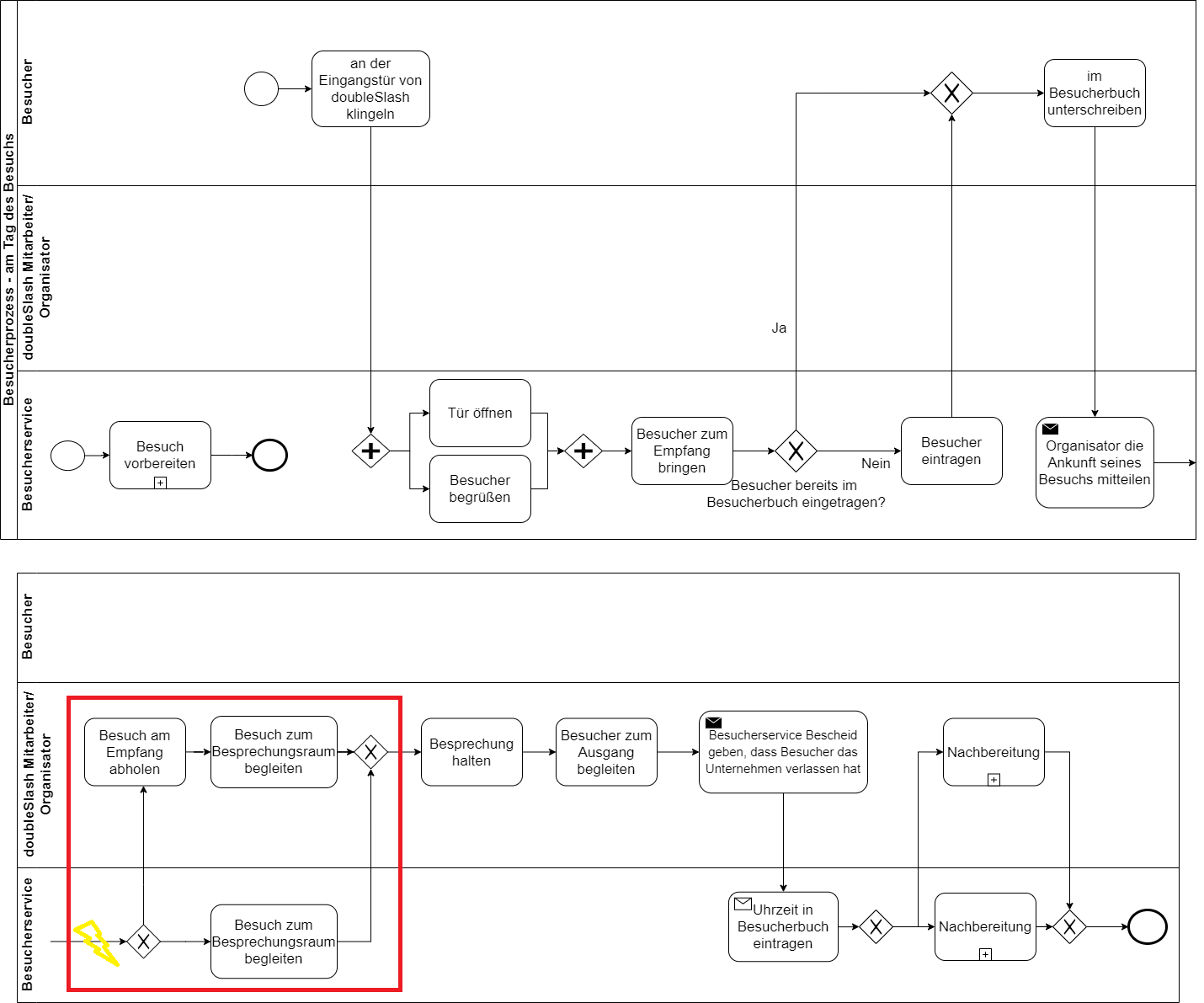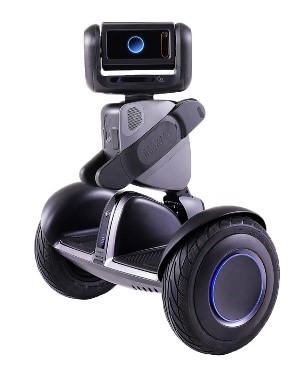Toy or added value: what do you need to consider when choosing a robot for visitor services?
Robots are no longer a rarity these days. In the living room, for example, robots drive across the floor, ensuring a clean room and thus relieving the homeowners, who look forward to a clean house after a hard day's work.
who look forward to a clean house after a hard day's work. But robots are not only used in the home.
They are also becoming increasingly common in companies. Colleagues are happy to be relieved of difficult or time-consuming tasks. Many companies offer a visitor service that can be customized. At doubleSlash, we have taken the visitor service as an opportunity to investigate the use of robots.
The visitor service at doubleSlash as the basis for robot use
The visitor process at doubleSlash is shown in Figure 1. It starts with the visitor arriving at the company and being greeted by reception. The visitor's arrival is then forwarded to their contact person in the company, who collects the visitor from reception. Alternatively, the visitor service takes the guests to the meeting rooms where most meetings take place. The use of a robot should relieve the visitor service and the contact persons and take over the navigation of the visitors to the meeting rooms (corresponds to the red box). This prevents misunderstandings that can occur when tasks are assigned between the visitor service and the contact person. Another advantage is the cost and time savings. Many employees who are involved in the visitor service process could use their free time for more important tasks. In addition, a one-off payment is made when a robot is purchased, which mainly remains stagnant for the next few years. If the visitor service takes over the accompaniment of visitors, costs are constantly generated.

In addition, the use of robots conveys progressiveness - especially in an IT company. The use of robots also has a positive effect on visitors. They do not have to wait for their contact person, but can use the robot on site. This reduces waiting times at reception, for example. However, there are a few aspects to consider when introducing a robot. We have examined them as part of a thesis.
Important steps when introducing a robot
The following steps must be taken into account when introducing a robot into the company:
- Where do I want to use the robot?
- What requirements must the robot fulfill?
- What safety measures do I need to take?
- Which type of robot is suitable?
- Which robot model meets the requirements?
- Is the robot accepted in the company?
Where do I want to use the robot?
A suitable robot must be selected depending on the area of application. Will it be used on uneven terrain, will it come into contact with people or should it drive through a multi-storey building?
What requirements must the robot fulfill?
Once the question of where the robot is to be used has been clarified, functional requirements can be derived. If it is to be used in multi-storey buildings, for example, the robot must be able to use elevators or climb stairs. In addition, doors usually have to be opened in buildings. Especially when it comes to navigation, the robot relies on sensors to show it the way and prevent collisions with other people in the room.
What safety measures do I need to take?
Many companies have introduced security measures to protect internal confidential documents. Visitors are therefore usually not allowed to move around the company unsupervised. These security guidelines must also be guaranteed when using a robot. In general, it is not possible to make any statements about the required functions of the robot to comply with the security measures, as companies differ in their security precautions. However, care should be taken to ensure that the robot only operates in areas that are approved for visitors in terms of safety. Furthermore, it is important to protect not only the documents, but also the robots and/or people who are in the robot's workspace. As early as 1942, Asimov introduced robot laws that a robot should fulfill1:
- A robot must not (knowingly) harm a human being or allow harm to be caused to a human being through inaction.
- A robot must carry out the commands given to it by a human - unless such a command would conflict with rule one.
- A robot must protect its own existence as long as this protection does not conflict with rule one or two.
The robot must therefore be able to avoid obstacles and prevent collisions. For the use of a robot in the European Economic Area, the EU Machinery Directive must also be complied with.
Which type of robot is suitable?
There are many different types of robots on the market that can be considered depending on the requirements:
- Industrial robots
- Humanoid robots
- Mobile robots
- Service robots
Industrial robots are the type most commonly used in industry. These are used for assembly or manufacturing activities. However, they are static and therefore not suitable for use in the field of navigation.
Another type are humanoid robots. These resemble a human visually and are supposed to act like one. However, this type is still very much in the research phase and is rarely used in everyday life. Apart from the technical challenges, these robots are very cost-intensive.
For use in navigation, there is a type of robot that can be used more easily and cost-effectively: the so-called autonomous mobile robot.
Here we are dealing with mobile robots that have a certain degree of autonomy. The degree of autonomy differs depending on the robot model. In our case, we are looking for a robot that can navigate independently through the company while avoiding obstacles. This robot is dependent on human assistance when opening doors and operating the elevator. It is therefore advisable to have an audio output that can explain to the visitor where and to what extent they need help. The camera function is also essential for orientation in the company. Service robots are probably the best-known type of mobile autonomous robot. Whether mowing the lawn or vacuuming, these robots also help "non-informaticians". Operation is simple and requires no prior knowledge. For use in companies, this type of service robot needs to be adapted to the area of application.
Robot types at a glance
| Industrial robots | Humanoid robots | Mobile robots | Service robots | |
| Possible applications | Assembly | Research | Navigation | Mowing the lawn |
| Manufacturing activities | should act like a human being | Vacuum cleaning | ||
| Properties | Static | visually resemble a human | autonomous | Operation is simple, prior knowledge required |
| cost-intensive | ||||
| Technical challenge |
Which robot model meets the requirements?
Once a robot type has been found, the next step is to choose the robot model. The market for mobile robots is particularly large. However, it can be narrowed down quite well in terms of requirements. Here, too, it is not possible to make a general statement about which robot model fits perfectly into the company, as the requirements of the robot differ depending on the design and room layout. For us at doubleSlash, however, the robot model "Segway Loomo" has qualified.

This robot can navigate autonomously, detect obstacles and prevent collisions with the help of its camera, ultrasonic and infrared sensors. The robot relies on the help of visitors to operate the elevator and open doors. Communication with the visitor takes place via voice output.
Is the robot accepted in the company?
When the robot is introduced into the company, it is important that it is accepted and embraced as a worker by everyone involved. Especially in the area of visitor service, it is important that the robot has a positive influence on customers and visitors. A survey conducted met with skepticism among the participants. Many see the use of robots as progressive and are prepared to accept them to reduce waiting times and relieve the burden on visitor services. However, the survey participants are reluctant to forego the human conversation that would then no longer be necessary.
Conclusion
In conclusion, it can be said that the use of robots to accompany visitors only represents a small part of the visitor process and therefore reduces the workload slightly. Nevertheless, it can not only support the visitor service, but also the organizers who are expecting the visit. The advantages clearly lie in the cost and time savings. In addition, the robot ensures a clear distribution of tasks. When choosing a robot, there is no ONE robot that fits every company. Each company must decide for itself which robot can meet its requirements and how many compromises it is prepared to make. The safety guidelines are particularly important here! At doubleSlash, no security guidelines are violated. The only compromise that has to be made is that visitors are still somewhat skeptical about the robot. However, it can be assumed that they will get used to the new worker. Nothing stands in the way of using the Segway Loomo! Perhaps it has a future in visitor services.
Do you already use robots in your company? If so, please share your findings with us and comment directly below this article or send us an email.
1 Maier, H. (2016). Fundamentals of robotics. Berlin; Offenbach: VDE Verlag GmbH.

